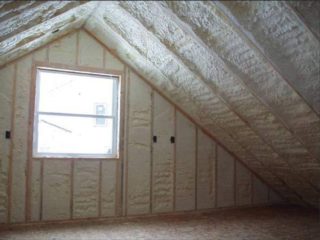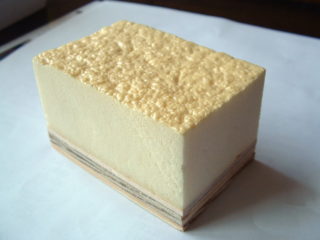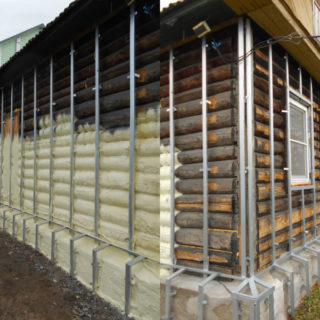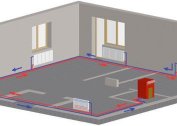Rising bills for heating and malfunctions in the utilities make us think about wall insulation with polyurethane foam, as it is considered to be the most effective solution to the problem of heat and frost. Polymer material appeared on the domestic market relatively recently, but managed to assemble a large army of adherents. If you have certain skills, you can apply it yourself. To do this, you need to purchase professional equipment and learn the rules for spraying polyurethane foam.
Technology of production and application of material
Polyurethane foam is a polymer having a porous or spongy structure. The main part of the finished substance is carbon dioxide, enclosed in open or closed cells with thin walls. Foamed polyurethane foam is obtained by mixing together liquids, each of which differs in a static state. After the connection, a reaction occurs, accompanied by the rapid release of carbon dioxide. As a result, the starting material increases in volume by 30–40 times and solidifies before air leaves it.
Polyurethane foam insulation is carried out using such means:
- Household. They are ready-to-use aerosol cans with a capacity of 500-2000 ml. They are sold in hardware stores and are designed for local use in solving small construction and repair tasks. Household polyurethane foam insulation is used to seal large gaps after installing windows and doors, laying pipes, installing floor and ceiling. To cover 1 sq.m. with a layer of 4 cm leaves one can with a capacity of 1000 ml.
- Professional. Thermal insulation with polyurethane foam of large objects is carried out using special industrial equipment of compressor type. PPU insulation is delivered to the place of work in sealed containers. After connecting to the compressor and setting the parameters on the control unit, pressure is applied to the tank. Liquid components are passed through the hoses to the nozzle, where they are mixed. Installations are used for polyurethane insulation of walls of houses and engineering structures, foundations, pipelines and other objects of any area and configuration.
Thermal insulation of polyurethane foam is divided into types intended for application to steel, concrete, brick and wood. When placing an order or purchasing PPU, this feature must be taken into account. It is due to the fact that the sprayed polyurethane foam has various properties with respect to strength and vapor permeability.
Varieties of polyurethane foam for insulation
Technical characteristics of polyurethane foam are determined by the composition of the final product exiting the nozzle. By changing the proportions of the ingredients, it is possible to obtain the foam of the desired property for a particular object.
Lightweight open-cell polyurethane insulation is a soft material characterized by such qualities:
- elasticity;
- flexibility,
- high hygroscopicity;
- ease;
- low density.
Foam rubber is used for the manufacture of pillows, mattresses, washcloths, lining for clothes. Easy insulation PPU is used for thermal insulation of apartments from the inside, and also as a filler for containers for transporting fragile items.
Rigid closed-cell polyurethane foam after hardening forms a dense and solid porous substance resembling polystyrene foam.
The material has the following qualities:
- hardness;
- strength;
- water tightness;
- sound absorption.
The polymer has a wide range of applications. It is used for insulation of residential and administrative buildings, engineering and agricultural facilities. Insulation is in demand in the production of refrigerators and boilers, where it fills the internal voids of household appliances.
The most popular brands of polyurethane foam in our country are Polynor and Tepli, which have the best performance characteristics.
Pros and cons of using technology
When deciding how to insulate real estate, the owners are faced with a difficult choice: to use polystyrene foam, mineral wool or stop at PPU.
Warming a house with polyurethane foam gives the following advantages:
- Environmental Safety. Even the gas released during application does not pose any harm to humans and the environment. After hardening, the material becomes completely safe.
- Durability. The experiments on artificial aging made it possible to determine what polyurethane foam will look like after 50 years of operation. As it turned out, its technical characteristics have not changed.
- Speed of application. There is no need for thorough preparation of the base and use of adhesives. The composition has high adhesion, immediately and firmly adheres to any surface.
- Lightness combined with durability. The material does not burden the structure and makes them stronger.
- Creating a continuous coating layer. When expanding, the foam fills all the cracks and voids. Lack of cold bridges and open joints.
- Wide temperature range of operation. Polyurethane foam does not change its characteristics at temperatures from absolute zero to furnace heat.
- Low thermal conductivity. This indicator is 4 times better than polystyrene foam and 2 times better than mineral wool.
- There is no need to use fasteners and frame structures.
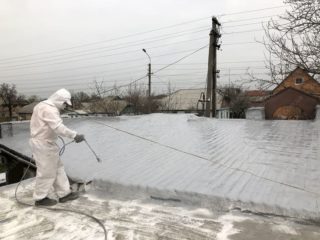
Along with the pros, PPU also has disadvantages.
- Ultraviolet damage. To prevent the destruction of the material, it must be treated with paint, sealed with plaster or decorative panels. Underground such measures are not needed.
- Smoldering under the influence of an open flame. During this process, carbon monoxide is released.
- To carry out the insulation of large areas, special equipment is needed. It is not advisable to purchase it for a one-time promotion, and specialists are asking for a considerable price for their services.
Despite the high cost of the technology, it pays off in a few years, in the long run it gives a good profit due to efficiency and the absence of the need for periodic repairs.
What conditions are necessary for insulation with polyurethane foam
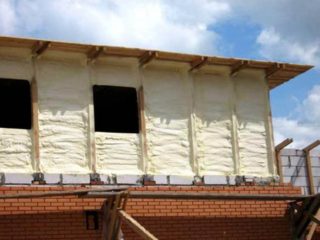
Warming with polyurethane foam does not require special conditions, since this material is designed for use in a wide temperature and humidity range.
It is necessary to take into account such nuances:
- The optimum value is considered to be ambient temperature + 15-30 ºС. In the cold, the solution thickens and foams worse. In the heat, it greatly increases in volume, which leads to the formation of a layer with reduced density and strength.
- Lack of strong wind. Gusts can blow off foam, tear it off the base and crush it.
- Dry weather. Since buildings are insulated from the outside, foam cannot be applied to rain. Drops of water will wash the solution and make holes in the solidifying surface.
- If frames or wall cavities are filled, the supporting structures must be pre-strengthened, as the foam can deform or break them when expanded.
- Use of serviceable equipment and experience in its operation. The effectiveness of the finished coating depends not only on the quality of the goods, but also on the correctness of the settings.
When contacting specialists, it is recommended to study their resume in order to be sure of a positive outcome of the upcoming warming event.
DIY polyurethane foam spraying
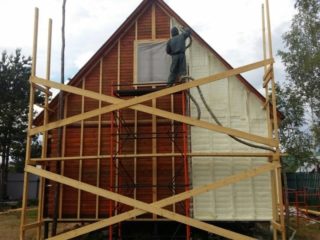
The process of spraying polyurethane foam must begin with preparatory work. Despite the fact that this material is characterized by excellent adhesion and corrosion resistance, a number of actions are required. Old paint, plaster, oilcloth and other materials that may subsequently move away from the base and fall off with the foam should be cleaned from the surface. It is necessary to extract from the walls all protruding metal fragments. They can become bridges of cold, and the cause of decay processes in wood. It is also necessary to clean the base from oil stains on which the polyurethane foam will not adhere.
In the process of applying PPU, it is recommended to adhere to the following rules:
- Before starting work, close the frames, glass and door leaves with plastic wrap. Foam is extremely difficult to remove even with chemicals. It is imperative to use a mask and rubber gloves.
- Warming should begin by filling in inaccessible places and local areas - corners, joints of logs, channels for chimneys and ventilation.
- It is advisable to apply PPU continuously, moving the spray gun horizontally, gradually rising from the bottom up.
- Layer thickness is determined visually or by marks. At a time, no more than 5 cm can be applied. The next spray can only be done after the previously created one has completely dried. The thickness of the insulation is considered to be optimal 80-150 mm, depending on the climatic conditions of the region.
Additional finishing of PPU is not required, but immediately after solidification it must be protected from ultraviolet radiation.
